The Helix Centre, part of the Institute of Global Health Innovation, is helping stroke patients to manage their recovery and increase their independence, with a wearable tool that provides support for the rehabilitation of their arm and hand.
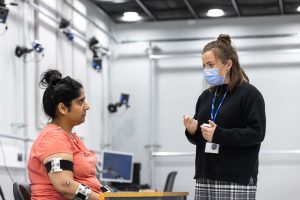
OnTrack Rehab is a platform that combines tracking of arm movements through a smart watch with personalised virtual coaching and dedicated clinical support. The system allows stroke patients to convert every-day activities into productive rehabilitation, and stroke therapists to monitor and help guide the patients’ progress. The development of the platform has been led by a multidisciplinary team at Helix including Gianpaolo Fusari (Project Lead) and Clare McCrudden (Engagement Lead). Gianpaolo and Clare recently ran a data collection experiment involving 20 stroke survivors to improve the software behind OnTrack.
Sana, a stroke survivor, volunteered to participate in this experiment, and met with us to describe her experience. Senior Occupational Therapist Simone Welch works in the stroke team at Charing Cross Hospital (Imperial College Healthcare NHS Trust), and chatted with us about the medical support for stroke survivors.
Experiencing stroke
In 2021, Sana experienced weakness in her left side following a medical procedure, and ultimately was diagnosed with a stroke. “I felt lucky in my stroke – though not lucky to have a stroke! – because stroke outcomes could be more significant.”
Sana’s physical symptoms such as some limited arm movement required ongoing management and rehabilitation as well as sensory-based issues, like those of many stroke survivors. But it can be difficult for those who’ve had a stroke to know what to expect. Sana described that support came not only from her medical team, but beyond – reading information on the internet to understand her issue, and the information provided by medical charities.
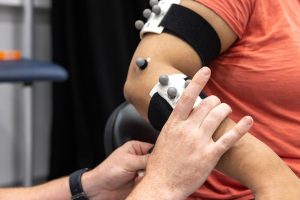
During a visit to hospital, an NHS physio checked that Sana could do simple everyday tasks, like brush her hair. But at home, it was more challenging to engage with the ongoing exercises.
Sana felt that the support and rehab she needed wasn’t as easy to see as most of her impairments were more hidden and not so obvious. “I am grateful that it could have been worse but if I had something more significant and visible then people would be taking me more seriously.” So when the Stroke Association sent a physiotherapist to her house for assessment and gave her exercises it was the beginning of better support.
“When it’s painful you just don’t want to do [the exercises],” Sana said. With the difficulty of engaging with exercises, plus limited face-to-face support during the pandemic and the lack of services tailored for younger people who’ve had a stroke, tailored support is needed.
As a young person surviving a stroke, Sana wanted to see support that would allow for variabilities in age and outcome, rather than a ‘one size fits all’ approach. So the invitation to participate in OnTrack’s stroke rehabilitation was appealing. Sana felt that by participating in the research, her experience was able to help others, especially when those people did not fit the ‘usual’ stroke survivor’s demographic.
One aspect of OnTrack that Sana liked was the idea of “meaningful movements”. Physiotherapy rehabilitation requires hundreds of specific or purposeful movements each day, which felt unattainable. But with the smart-watch style device, Sana describes feeling more able to achieve goals – through every-day tasks such as brushing hair and doing dishes – which count as meaningful arm movements for rehab.
“This would have been useful to me; I need to engage with something interactive,” Sana said. That’s where the app helps – measuring activity and giving motivation/feedback reinforced through different channels within the watch and app, and through the support provided by therapists.
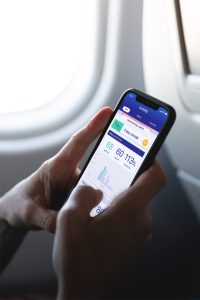
Sana’s message to survivors: “It does get better.” Sana recommends to engage with the exercises, and found YouTube videos and stroke support charities helpful in her recovery.
Stroke therapy
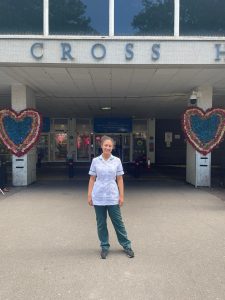
Simone first saw the OnTrack technology in its very early stages – when in-person service provision was really limited during the pandemic. “[It] provided an intervention that allowed [stroke survivors] to continue with the upper limb recovery”, said Simone, as well as to participate in research.
Within 24 hours of being admitted to the HyperAcute stroke unit where Simone works, the patient will be referred for a therapy assessment – be it speech, physical or occupational therapy. But the rehab certainly doesn’t end there. Where some boroughs have intensive community stroke therapy available, including at the patient’s own home, the vast majority of rehab happens when the patient is on their own. “There is a concept called self-management which is really, really important,” where patients take on responsibility for their progress and their rehabilitation.
Simone wants her patients to be able to be discharged and return home. And the app would really support them to be able to track how they’re doing with their arm and hand recovery when not in hospital. When stroke patients like Sana have an arm weakness, OnTrack Rehab can send reminders, and help them to focus on what they need to achieve. “So it’s a bit like a step counter for the arm,” explains Simone.
As any movement of the arm – actual exercises or using your arm to wash your face or to feed yourself – is beneficial, tracking with OnTrack is a really positive solution.
Keeping on track
There’s plenty of hope about what OnTrack could help with. Simone said: “I think it would help guide conversations between therapist and patient on how they can do more outside of their sessions.” Plus, it gives data that therapists can go through with their patient to support them to reach their goals.
“There’s a lot you can do to support someone’s overall quality of life and their well-being”, says Simone. The app could prompt therapists to ask: “I can see you were really active at this time of the day, but not so much here – what was happening?” This is particularly important when therapists may only see their patient for an hour, as the app allows you to know what’s happening in the other 23 hours of the day.
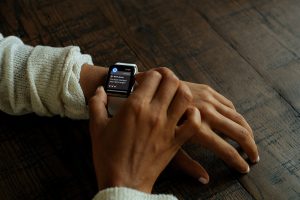
For OnTrack Rehab, Clare and Gianpaolo are working to evaluate the device and its impact with more people and this year a new clinical trial will begin.
Gianpaolo said: “The data and insights that we gathered with the collaboration of Sana and other stroke survivors during Phase 1 has helped us to improve the OnTrack experience as a whole. One big change that we can’t wait to test during Phase 2 is the inclusion of smarter prompts delivered directly to the patient’s wrist, hopefully we will be able to see how these tailored messages motivate people to increase the use of their arm in more varied activities.”
“We are delighted to have members of the research study as part of a wider group of stroke survivors and carers guide us through the next phase of OnTrack Rehab, piloting it in the NHS. We expect to be able to enhance the both patient and carer’s experience, and also embed new co-designed features to keep users motivated and supported.” said Clare
Find out more about OnTrack and the user-centred designs created by the Helix Centre.